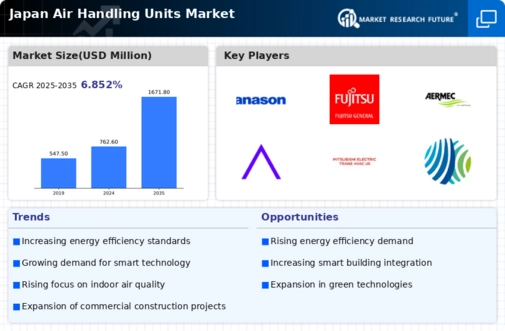Regulatory Compliance and Standards
The air handling-units market in Japan is significantly influenced by stringent regulatory compliance and standards aimed at enhancing energy efficiency and environmental sustainability. The Japanese government has implemented various regulations that mandate the use of energy-efficient systems in commercial and residential buildings. This regulatory landscape encourages manufacturers to innovate and develop advanced air handling units that meet these standards. As a result, the market is witnessing a shift towards products that not only comply with regulations but also offer superior performance. The emphasis on compliance is expected to drive market growth, as businesses seek to avoid penalties and enhance their operational efficiency. Furthermore, adherence to these regulations can lead to potential cost savings in energy consumption, thereby making compliance a critical driver in the air handling-units market.
Increased Awareness of Indoor Air Quality
The growing awareness of indoor air quality (IAQ) among consumers and businesses is a significant driver of the air handling-units market in Japan. As health concerns related to air pollution and allergens rise, there is a heightened demand for air handling units that can effectively filter and purify indoor air. This trend is particularly evident in commercial spaces, where maintaining a healthy environment is essential for employee productivity and customer satisfaction. Market data indicates that the demand for air purification systems integrated into air handling units is expected to increase by approximately 20% over the next five years. This shift towards prioritizing IAQ is likely to influence purchasing decisions, prompting manufacturers to innovate and offer products that address these concerns, thereby driving growth in the air handling-units market.
Technological Advancements in HVAC Systems
Technological advancements play a crucial role in shaping the air handling-units market in Japan. Innovations in HVAC technologies, such as variable refrigerant flow systems and advanced filtration methods, are enhancing the performance and efficiency of air handling units. These advancements not only improve energy efficiency but also contribute to better indoor air quality, which is becoming increasingly important to consumers. The market is witnessing a trend towards the adoption of smart technologies that allow for real-time monitoring and control of air handling systems. This shift is expected to drive market growth, as businesses and homeowners seek to optimize their energy consumption and reduce operational costs. The integration of these technologies into air handling units is likely to create a competitive edge for manufacturers in the air handling-units market.
Urbanization and Infrastructure Development
Japan's rapid urbanization and ongoing infrastructure development are pivotal drivers of the air handling-units market. As urban areas expand, the demand for efficient heating, ventilation, and air conditioning systems increases. The government has invested heavily in infrastructure projects, including commercial buildings, hospitals, and educational institutions, which require advanced air handling solutions. According to recent data, the construction sector in Japan is projected to grow by approximately 3.5% annually, further fueling the demand for air handling units. This growth is likely to be accompanied by a focus on integrating modern technologies that enhance energy efficiency and indoor air quality. Consequently, the air handling-units market is poised to benefit from the increasing need for sophisticated systems that cater to the evolving demands of urban environments.
Sustainability and Green Building Initiatives
Sustainability and green building initiatives are increasingly shaping the air handling-units market in Japan. The government and various organizations are promoting environmentally friendly construction practices, which include the use of energy-efficient air handling systems. These initiatives aim to reduce carbon footprints and promote sustainable living. As a result, there is a growing demand for air handling units that comply with green building standards, such as LEED certification. This trend is expected to drive innovation in the market, as manufacturers develop products that not only meet energy efficiency criteria but also utilize sustainable materials. The potential for cost savings through reduced energy consumption further incentivizes the adoption of these systems, making sustainability a key driver in the air handling-units market.





















Leave a Comment